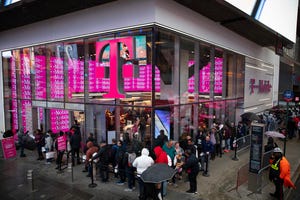
T-Mobile on Monday announced it now covers 200 million people with its speedy midband 5G network – more than a month ahead of schedule. Perhaps more importantly, the company's top networking executive also said that, by the end of the year, T-Mobile would employ a total of 100MHz of spectrum across that network, supporting average speeds of 400 Mbit/s.
At the same time, Verizon and AT&T are being forced to delay the deployment of their own midband 5G networks. And even if they're able to switch on those networks, they still won't be able to employ nearly as much spectrum as T-Mobile can.
"We're years ahead of where our competition is today," T-Mobile's networking chief, Neville Ray, told an investor conference Monday.
Taken together, the developments clearly show that T-Mobile is building a lead in the rollout of 5G in the US. And that situation, coupled with its relatively inexpensive 5G pricing, could create an unassailable leadership position for T-Mobile in the coming years, according to company executives.
Lots of the right kind of spectrum
Midband has often been described as the "Goldilocks" spectrum for 5G. Such spectrum supports broad coverage areas and speedy connections, unlike the lowband and highband spectrum that all of the nation's operators have been using for 5G until now.
Indeed, the value of midband spectrum for 5G has been clearly on display in FCC spectrum auctions this year that have collectively raised more than $100 billion in winning bids.
But just as important as the type of spectrum is the amount of it. Just as multi-lane freeways can handle far more traffic than single-lane roads, so too can 100MHz of midband spectrum handle significantly more mobile data traffic than just 10MHz of that same midband spectrum.
T-Mobile owns around 160MHz of midband spectrum in the 2.5GHz band. That's the spectrum band it's now using to cover 200 million people, or roughly 80% of its customer base. T-Mobile initially launched its midband 5G service with just 40MHz of spectrum, but by the end of the year it expects to increase that number to 100MHz. That's part of why T-Mobile has reported dramatically increasing the average speeds available on its midband network from around 200 Mbit/s last year to 400 Mbit/s by the end of this year.
Into 2022 and beyond
T-Mobile has said it hopes to expand its midband 5G network to a total of 250 million people by the end of 2022, though Ray said the operator could increase that figure with additional investments.
"We'll see," Ray said when questioned on the topic. "It's a great time for us to do that."
Further, Ray said that, starting in the next few weeks, T-Mobile will begin implementing carrier aggregation technology across its 2.5GHz and 600MHz spectrum holdings. Carrier aggregation technology essentially glues together transmissions in various spectrum bands, thereby dramatically increasing users' total overall connection speeds. Ray didn't say whether customers would see a speed boost due to the move, but he said that T-Mobile would begin updating the "vast majority" of its phones with 2.5GHz and 600MHz carrier aggregation technology starting in the first quarter of next year.
Ray also said that T-Mobile would eventually work to deploy 5G across the rest of its spectrum holdings, including its PCS and AWS licenses. He said that T-Mobile would then look to potentially deploy Voice over 5G, or VoNR. He added that T-Mobile, like its competitors, continues to transmit voice calls over its 4G LTE network. He said that means T-Mobile likely won't be able to score a leading position in wireless reliability testing like it can with network speed testing.
C-band delays
While T-Mobile executives boasted of the operator's new midband 5G performance metrics, the company's rivals quietly fretted over troubles surrounding their own midband 5G deployments.
Both AT&T and Verizon spent billions of dollars earlier this year for midband C-band spectrum licenses that were scheduled to be available for commercial use by the end of this year. However, due to ongoing interagency squabbling among the FCC, NTIA and Federal Aviation Administration (FAA), those plans have been put on hold.
And some analysts are warning that the situation might get worse before it gets better.
"The situation remains fluid and the lack of FAA incentives to stand down makes it difficult to have conviction in how this will end," warned the financial analysts at New Street Research in a note to investors last week.
The dustup is due to worries among airlines that 5G in C-band spectrum could interfere with the radio altimeters in some aircraft. The wireless industry, represented by the CTIA, is loudly arguing that won't happen. Nonetheless, the White House is currently mediating negotiations on the topic between the FCC and the FAA.
According to The Wall Street Journal, FAA officials are preparing to issue unknown "restrictions" sometime next month.
T-Mobile's Ray said he's unsure how the situation will be resolved. He pointed out that T-Mobile owns around 40MHz of C-band spectrum, but it purchased licenses that won't be released for commercial use until 2023. "I don't know how quickly it will happen," Ray said of when the debate over C-band interference will be resolved.
Nonetheless, the fact remains that T-Mobile already covers 200 million people with 100MHz of midband spectrum. If AT&T and Verizon address the FAA's interference concerns, they still won't be able to match those figures. AT&T plans to cover around 75 million people with around 40MHz of midband spectrum by the end of next year, while Verizon hopes to cover around 100 million people with 60MHz of midband spectrum by March of next year. However, Verizon, AT&T and T-Mobile all plan to expand their 5G midband networks throughout next year and 2023, a situation that will force T-Mobile to work to cash in on its early lead.
Related posts:
— Mike Dano, Editorial Director, 5G & Mobile Strategies, Light Reading | @mikeddano
About the Author(s)
You May Also Like











